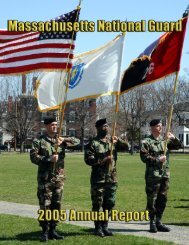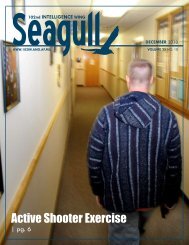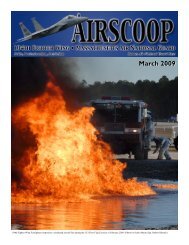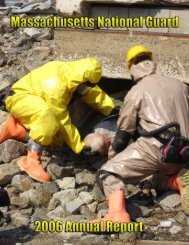presorted standard us postage paid permit #88 enfield, ct
presorted standard us postage paid permit #88 enfield, ct
presorted standard us postage paid permit #88 enfield, ct
You also want an ePaper? Increase the reach of your titles
YUMPU automatically turns print PDFs into web optimized ePapers that Google loves.
Combat Medical<br />
Advanced Skills<br />
Summer Training<br />
The Massach<strong>us</strong>etts National Guard Regional<br />
Training Institute, in cooperation with 126<br />
Brigade Support Battalion, condu<strong>ct</strong>ed Combat<br />
Medical Advanced Skills Training at Camp<br />
Edwards during Annual Training 2007. This new<br />
30-hour course is required of all combat medic<br />
Soldiers.<br />
According to 1st Sgt. Dan Patterson, Charlie<br />
Company, 126th Brigade Support Battalion, 100<br />
percent of Soldiers passed the course and six<br />
CMAST trainers were certified. Patterson reports<br />
that course participants will be able to <strong>us</strong>e continuing<br />
education credits from the course for<br />
civilian Emergency Medical Technician re-certification<br />
requirements. For more information on<br />
CMAST courses, please consult the Regional<br />
Training Institute. ✯<br />
Equal Opportunity<br />
Leader<br />
By Maj. Jack McKenna, Joint Force Headquarters Public Affairs<br />
Imagine that you have completed basic and advanced individual training.<br />
And now, after colle<strong>ct</strong>ing a few years of training under your belt,<br />
you’re finally fully qualified on your individual weapon and the unit’s<br />
crew-served weapons. The long anticipated mobilization order arrives<br />
and you hit the mob site running … no problem; you are trained and<br />
ready to go.<br />
Once in theater, however, things are different. You are no longer doing<br />
your assigned job, instead you find yourself constantly getting assigned<br />
tasks that “keep you in the wire.” Your first sergeant tells you that<br />
beca<strong>us</strong>e you remind him of his own 19-year-old daughter he isn’t letting<br />
you go outside the “wire.” Who do you turn to for help?<br />
The answer: your unit’s Equal Opportunity Leader. New regulations state<br />
unit commanders m<strong>us</strong>t appoint an Equal Opportunity Leader. If your<br />
unit is deploying, it is expe<strong>ct</strong>ed to arrive at the mobilization site with a<br />
Department of Army certified EOL. However, due to time constraints the<br />
mobilization station will no longer provide the training.<br />
Sgt. Danielle Sullivan of C Medical Company, 126 Brigade Support Battalion, performs hasty evacuation procedures<br />
on Soldier during simulated mortar attack while CMAST course instru<strong>ct</strong>or Sgt. First Class Troy Mobley<br />
of Regional Training Institute provides instru<strong>ct</strong>ion. The course had a 100 percent pass rate with an average<br />
score of 87 out of 100 points. All Massach<strong>us</strong>etts National Guard combat medics are required to complete the<br />
30-hour training. (Photo: Capt. Jeffrey Cox)<br />
As a result, the EOL course proponent school, located at Fort Jackson,<br />
fielded a 60-hour EOL training and certification course to the National<br />
Guard Bureau for immediate implementation.<br />
Under the dire<strong>ct</strong>ion of Lt. Col. Doris Lopilato, the Senior Northeast<br />
Regional Representative to the Army National Guard‘s National Equal<br />
Opportunity/Equal Employment Opportunity Diversity Committee, Lt.<br />
Col. David Cuttle and CW5 William Bouchard of the State Equal<br />
Employment Management Office became the first to offer the<br />
Department of the Army’s Equal Opportunity Leader Course at Camp<br />
Edwards last Aug<strong>us</strong>t.<br />
Scenarios j<strong>us</strong>t like the one above were disc<strong>us</strong>sed in a group setting with<br />
the 14 students in attendance from throughout New England. The<br />
curriculum consisted of Army learning styles indicators, Ahe army’s EO<br />
program and policies, role of the EOA and EOL, socialization process,<br />
values, attitudes, behaviors, communications process, effe<strong>ct</strong>ive and<br />
a<strong>ct</strong>ive listening and effe<strong>ct</strong>ive feedback. Students were also required to<br />
complete assignments independent of the classroom.<br />
Thanks to the hard work of Lopilato and her team, the course was a great<br />
success and 14 soldiers are now deployable as Equal Opportunity<br />
Leaders for their respe<strong>ct</strong>ive organizations. ✯<br />
The Force of Freedom 27
















